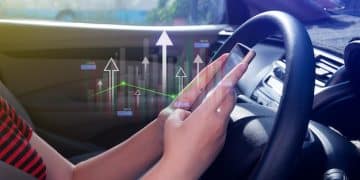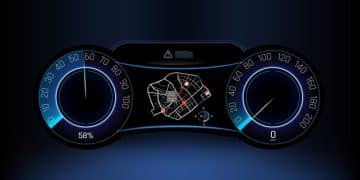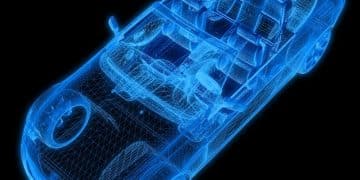AR Dashboards: The Future of Driver Information Systems?

Augmented Reality (AR) dashboards represent a cutting-edge evolution in driver information systems, potentially transforming how drivers perceive and interact with real-time data, vehicle diagnostics, and navigational cues, enhancing safety and driving experience.
Imagine a future where your car’s dashboard seamlessly blends digital information with the real world. Augmented Reality (AR) dashboards are rapidly evolving, promising to revolutionize driver information systems by projecting crucial data directly onto the windshield or integrated displays.
Understanding Augmented Reality (AR) in Automotive
Augmented Reality (AR) is no longer confined to science fiction. It’s increasingly becoming a reality in various industries, and the automotive sector is no exception. Understanding how AR integrates into vehicles is crucial to appreciating its potential impact.
What is Augmented Reality?
AR enhances our perception of reality by overlaying computer-generated images onto the real world. Unlike Virtual Reality (VR), which creates a completely simulated environment, AR supplements reality without replacing it.
AR Applications in Vehicles
In automotive applications, AR can provide drivers with real-time information projected onto the windshield or display screens. This includes navigational directions, speed limits, hazard warnings, and even points of interest along the route.
- Enhanced Navigation: AR can overlay directional arrows directly onto the road ahead, making navigation more intuitive.
- Adaptive Cruise Control: AR can visualize the distance between your vehicle and the vehicle ahead, improving adaptive cruise control functionality.
- Blind Spot Monitoring: AR can highlight vehicles in your blind spots, increasing safety.
- Parking Assistance: AR can overlay guiding lines and distance markers, simplifying parking maneuvers.
The integration of AR into vehicles aims to improve situational awareness and reduce driver distraction by presenting critical information in a natural and intuitive way.
How AR Dashboards Work
AR dashboards combine several technologies to create a seamless and informative driving experience. Understanding these components is essential to grasp the full potential of AR in automotive.
Key Components of AR Dashboards
AR dashboards rely on sensors, cameras, processing units, and display technologies to function effectively. These components work together to capture, analyze, and present relevant information to the driver.
Data Acquisition and Processing
Cameras and sensors collect data about the vehicle’s environment, including road conditions, traffic patterns, and nearby objects. This data is then processed by onboard computers to identify relevant information for the driver.
- Sensor Fusion: Combining data from multiple sensors provides a more accurate and comprehensive understanding of the surroundings.
- Real-Time Processing: Data must be processed in real-time to provide timely and relevant information to the driver.
- Object Recognition: Identifying and categorizing objects, such as other vehicles, pedestrians, and traffic signs, is crucial for AR functionality.
The processed data is then projected onto the windshield or an integrated display screen, creating an augmented view of the real world.
Benefits of Augmented Reality Driver Information
The integration of AR into driver information systems offers a range of potential benefits, from enhanced safety to improved convenience. These advantages are driving the adoption of AR technology in the automotive industry.
Enhanced Safety
AR dashboards can significantly improve driver safety by providing real-time warnings and alerts. By overlaying critical information directly onto the driver’s field of view, AR can reduce reaction times and prevent accidents.
Improved Navigation
AR navigation systems offer a more intuitive and user-friendly experience compared to traditional GPS systems. By projecting directional arrows onto the road ahead, AR can guide drivers through complex intersections and unfamiliar routes with ease.
Reduced Driver Distraction
By presenting information in a natural and intuitive way, AR dashboards can help reduce driver distraction. Essential data is displayed without requiring the driver to take their eyes off the road.
These benefits make augmented reality a compelling technology for enhancing the driving experience and improving road safety.
Challenges and Limitations
While AR dashboards offer numerous advantages, there are also challenges and limitations that need to be addressed. Overcoming these hurdles is essential for the widespread adoption of AR technology in vehicles.
Technological Challenges
Developing robust and reliable AR systems requires overcoming several technological challenges. This includes ensuring accurate data acquisition, real-time processing, and seamless display integration.
Cost and Complexity
The cost of AR technology is currently a barrier to its widespread adoption. The complexity of AR systems also adds to the manufacturing and maintenance costs of vehicles.
Regulatory and Safety Concerns
Regulatory bodies need to establish standards for AR displays to ensure they do not distract drivers or compromise safety. Addressing these concerns is crucial for gaining public acceptance.
- Data Privacy: Ensuring the privacy of driver and vehicle data is essential when using AR systems that collect and process information.
- Reliability: AR systems must be reliable and consistent in all driving conditions to avoid misleading drivers.
- Display Clarity: AR displays must be clear and easy to read in varying lighting conditions, including bright sunlight and nighttime driving.
Addressing these challenges and limitations is crucial for the successful implementation of AR dashboards in the automotive industry.
Future Trends in AR Dashboards
The future of AR dashboards looks promising, with ongoing research and development efforts focused on improving their functionality and integration. Several trends are shaping the evolution of AR technology in vehicles.
Advanced Display Technologies
New display technologies, such as holographic displays and waveguide optics, are being developed to create clearer and more immersive AR experiences. These advancements will enhance the visual quality and reduce the size and weight of AR displays.
Integration with Autonomous Driving Systems
AR dashboards are expected to play a crucial role in autonomous driving systems. By providing drivers with a visual representation of the vehicle’s perception and decision-making processes, AR can increase trust and acceptance of autonomous technology.
Personalized AR Experiences
Future AR dashboards will likely offer personalized experiences tailored to individual drivers. This could include customized information displays, adaptive interfaces, and personalized safety alerts.
These trends indicate that AR dashboards will continue to evolve and become an integral part of the driving experience in the years to come.
Conclusion
Augmented Reality (AR) dashboards hold the potential to significantly enhance the driving experience, making it safer, more convenient, and more enjoyable. By providing real-time information in a natural and intuitive way, AR can improve situational awareness and reduce driver distraction. While challenges and limitations remain, ongoing advancements in technology and regulatory frameworks are paving the way for the widespread adoption of AR dashboards in the automotive industry. As AR technology continues to evolve, it is poised to revolutionize how drivers interact with their vehicles and the world around them.
| Key Point | Brief Description |
|---|---|
| 🚗 Enhanced Safety | AR dashboards provide real-time warnings and alerts, improving driver reaction times. |
| 🗺️ Improved Navigation | AR navigation systems offer intuitive guidance through complex routes and intersections. |
| 👀 Reduced Distraction | By displaying data naturally, AR helps drivers keep their eyes on the road. |
| ⚙️ Future Trends | Advancements include personalized experiences and integration with autonomous systems. |
Frequently Asked Questions
▼
An augmented reality (AR) dashboard is a system that overlays computer-generated images and information onto a driver’s view of the real world, typically displayed on the windshield or an integrated display screen, to enhance situational awareness.
▼
AR dashboards improve safety by providing real-time warnings, highlighting potential hazards, and displaying critical information such as speed and navigation directions directly in the driver’s line of sight, reducing reaction times.
▼
The main components include sensors (cameras, lidar, radar), a processing unit to analyze data, and a display technology (windshield projection or integrated screen) to present augmented information to the driver.
▼
Potential downsides include the risk of driver distraction if the display is too cluttered, high initial costs, and concerns about data privacy and the reliability of the AR system in all driving conditions.
▼
Future AR dashboards are expected to integrate more seamlessly with autonomous driving systems, offer personalized user experiences, and utilize advanced display technologies like holographic projections to provide clearer and more intuitive information.
Conclusion
In conclusion, augmented reality dashboards are poised to transform driver information systems by enhancing safety, convenience, and the overall driving experience. While challenges remain, continued innovation and development promise a future where AR technology is seamlessly integrated into every vehicle.





